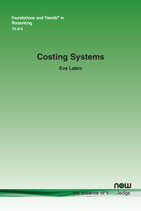Costing Systems
By Eva Labro, University of North-Carolina at Chapel Hill, Kenan-Flagler Business School, USA, Eva_Labro@unc.edu
Abstract
This monograph provides a structured overview of costing system research that can explain the variation in the characteristics and properties of costing systems found in practice based on firms’ source(s) of their demand for cost information. Costing systems are not developed in a vacuum but are designed to fulfill a purpose. In order to have a meaningful decision on the various demands for cost information, I start in Part 1 by exploring the different techniques firms can use to supply cost information to its managers and employees. Next, I discuss how even the most advanced costing systems will contain error, and present research on how the production environment affects this costing error and what firms can do to reduce the error, outlining important avenues for future research. Part 2 then moves onto the sources of the demands for cost information. I first discuss the decision-making objective of costing systems, and the requirements it places on the preferred measurement object, which resources to include in the cost measurement, and the desired properties of the costing system. The most voluminous literature here is on the capacity acquisition and allocation decision problem, but I cover the demands on costing systems to support customer portfolio decisions, inventory management decisions and decisions on managing competition as well. This part also explores the demands for costing systems for the identification of cost management opportunities and inventory valuation to support financial and tax accounting in a chapter each. Part 2 concludes with a chapter on cost information supporting performance measurement and control, again with respect to the preferred measurement object, which resources to include and the costing system’s preferred properties. Part 3 develops on the conflicting demands placed on costing systems by firms’ attempts at designing costing systems that serve multiple purposes. Furthermore, this part also discusses the nature of the strategic interactions between those different demands.
Costing Systems
Costing Systems provides a structured overview of costing system research to explain the co-existence of different costing practices. This body of research has come to prescriptive conclusions, which will of be valuable and insightful to practitioners designing costing systems and managers using reported cost data. The monograph is structured around four primary purposes of cost measurement: decision-making, cost management, inventory valuation for financial and tax accounting, and control and performance measurement. Part 1 of the monograph relates to the production or supply choices made by costing system designers. Part 2 moves onto the demand side for cost information. This monograph aims to be useful both to novices in the costing field who are searching for a primer on this literature as well as for people familiar with the literature who are interested in a structured overview and thoughts on where future research avenues may lead.
